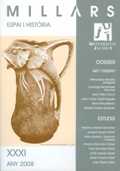Descubrir y usurpar. La otra cara de la expedición de Mopox
Article Sidebar

Main Article Content
Imilcy Balboa Navarro
Gerardo Cabrera Prieto
The Royal Commission of Guantánamo who developed their work on the island of Cuba between 1797 and 1802 aimed at studying the conditions that would allow the opening of new channels of communication and the settlement of remote locations. But the issue also had another object “undeclared”: reviewing the situation and status of land called realengos. Our work will focus precisely on the analysis of the role played by realengos during and after the issue, not just as the king’s lands that would form the basis of the proposed settlement, but also as a source of income to tax authorities and as a way of enhancing the heritage of the landowners; as well as its linkage with the changes taking place in the island around the conceptions of the uses and soil domains.
Article Details
How to Cite
Balboa Navarro, Imilcy; and Cabrera Prieto, Gerardo. “Descubrir y usurpar. La otra cara de la expedición de Mopox”. Millars: espai i història, vol.VOL 31, pp. 49-63, https://raco.cat/index.php/Millars/article/view/169287.
Most read articles by the same author(s)
- Marisol Mesa León, Gerardo Cabrera Prieto, The Cuban historical archives: sources for the historical investigation , Millars: espai i història: Vol. 35 (2012)
- Imilcy Balboa Navarro, Amparo Sánchez Cobos, Crossing the boundaries of the farm. The sugar society , Millars: espai i història: 2010: Vol.: 33
- Imilcy Balboa Navarro, A time of expansion and expulsion: The growth of plantations and the decline of minor crops , Millars: espai i història: 2010: Vol.: 33
- Gerardo Cabrera Prieto, The arrival of sugar in the countryside. The case of Puerto Príncipe , Millars: espai i història: 2010: Vol.: 33